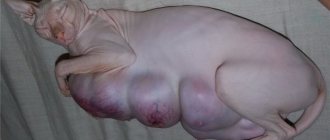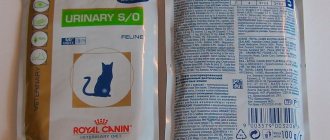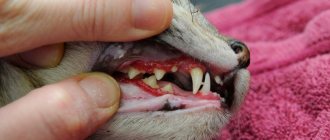Infectious respiratory diseases of domestic cats are common throughout the globe. They threaten the health of pets and cause a lot of trouble for owners. Viral rhinotracheitis, or feline herpes, is a disease with dangerous complications, although its first symptoms resemble a common cold.
- 2 Routes of infection
- 3 Symptoms of feline herpes
- 4 Diagnosis of the disease
- 5 How to treat rhinotracheitis in cats at home
5.1 Video with veterinarian recommendations for caring for a cat with rhinotracheitis
- 5.2 Features of treatment for kittens
What does it represent?
Feline herpes, otherwise known as FVR, is an acute, widespread infectious disease that affects the respiratory tract. Hypervirus-1 (FHV-1) is the most common type of rhinotracheitis virus. The infection negatively affects the mucous membranes of the sinuses, pharynx, and mouth, thereby causing inflammation of the upper respiratory tract, as well as conjunctivitis and ulcers on the surface of the eyes.
Rhinotracheitis in a cat
Rhinotracheitis in kittens and young cats is much more common than in adult animals. However, it is worth noting that the virus can be in the body of a pet for many years and not manifest itself in any way until a certain point.
An exacerbation of infection can occur against the background of such serious pathologies as FIV (feline immunodeficiency virus) and FeLV (feline leukemia).
In general, the general characteristics of the disease are as follows:
- incubation period – on average from 5 to 15 days;
- the active phase of rhinotracheitis usually lasts 2-4 weeks;
- susceptibility to disinfection – present;
- The lifespan of the virus in the external environment is about 24 hours.
During the incubation period, as well as during the active manifestation of the disease, the cat is a spreader of the infection.
Risk zone for herpes infection
Transmission of the virus from one animal to another occurs through contact with infected secretions from the eyes, nose and mouth of a sick cat. The risk of infection arises in the process of mutual licking, using a common toilet, water and the same utensils for water and food.
Sick cats during pregnancy can transmit the virus to their offspring. Rhinotracheitis is a highly contagious phenomenon, therefore, when animals are very crowded, as happens in nurseries or shelters, the infection spreads very quickly.
Some cats are hidden carriers of the virus. They do not show symptoms of the disease, but despite this, the risk of infection for other pets remains as high as during the active phase of rhinotracheitis. The manifestation of symptoms of the disease in carriers of the virus can be triggered by a stressful situation. They usually go away on their own after just a few days.
Feline herpes
Cats of all breeds and ages are at risk of contracting herpes. Still, there are certain factors and conditions that significantly increase the likelihood of infection spreading. These include, in particular:
- crowded keeping of animals;
- stressful situations;
- weakened immune system;
- young age (kittens) or, conversely, old age;
- brachycephalic (flat-faced) breeds (for example, Persians);
- lack of vaccination;
- unfavorable living conditions (insufficient ventilation of the room, lack of heat, dampness);
- presence of other infectious diseases;
- direct contact with a carrier of the virus (infection occurs by airborne droplets);
- mechanical transmission of the virus (through dishes, toys, toilet);
- failure to comply with hygiene standards;
- visiting exhibitions;
- trips, travel;
- knitting
Feline herpes is seasonal, and its prevalence peaks during the cold and damp seasons.
Kittens
How to neutralize the virus in the environment?
The causative agent of feline rhinotracheitis is considered highly contagious - capable of rapid infection. However, if it becomes necessary to bring a healthy animal into a room where a sick one was previously kept, its disease can be easily prevented. The herpes virus is easily destroyed in the environment using conventional disinfectants containing chlorine. For example, a light solution containing one part regular bleach diluted with 32 parts water is an effective disinfectant for treating hard surfaces that are not susceptible to the attack of chlorine.
Items suspected of being infected should be generously treated with a disinfectant solution. If it is not possible to replace the dishes, tray and other household items that belonged to the sick cat, it is recommended to soak them in the same solution for at least five minutes, and then rinse thoroughly in running water.
Soft objects can be treated against the virus by regular machine washing at high temperatures and detergents. Objects that cannot be treated with a disinfectant solution or washed are thoroughly washed under running water with plenty of soap. Upholstered furniture can be treated with a special shampoo, although in most cases this is not required - just wait a day. During this time, the virus dies outside the living cell, even in a humid environment.
If calcivirus is present in the causative agents of rhinotracheitis, the exposure of the premises after the sick animal should be longer - at least 10 days.
After contact with a sick cat, hands should be thoroughly washed in warm running water and soap, and then treated with an alcohol-based disinfectant solution. It is recommended to cut your nails.
Despite the highly contagious nature of rhinotracheitis, it is important to understand that most domestic cats are at low risk of infection. For a cat to get sick, it must be in the same area as the patient and have direct or indirect contact with her through household items.
Routinely, cats infected with rhinotracheitis can be found in pet shelters, where the disease often becomes epidemic, as well as in stray animals. Therefore, a domestic cat that does not leave the house is not afraid of rhinotracheitis.
Due to the special structure of the muzzle, Persian cats are more susceptible to infection with rhinotracheitis and the disease itself is more severe in them.
Video
Symptoms of viral rhinotracheitis
The exact picture of the external manifestations of this pathology will depend on the nature of its influence on the animal’s body. General symptoms of rhinotracheitis may look like this:
- sneezing;
- rhinitis;
- inflammation of the mucous membrane of the eye;
- ulcers on the cornea;
- discharge from the eyes;
- labored breathing;
- fever;
- lethargy;
- salivation;
- poor appetite;
- pneumonia;
- the appearance of ulcers on the tongue;
- miscarriages or spontaneous abortion in pregnant cats.
Lethargy
The onset of the disease occurs suddenly and is accompanied by bouts of sneezing and nasal discharge. Next, a cough may appear, inflammation of the eyes occurs, from which there is constantly a discharge of a watery or purulent nature. Then characteristic ulcers develop on the cornea of the eye, the cat loses interest in food, apathy and drowsiness appear.
Sick cats are often exposed to secondary infections. Even after successful treatment, symptoms of rhinotracheitis will periodically return. Provoking factors in these cases are stress, as well as the use of steroid hormones.
Antibacterial therapy
Antibiotics are usually prescribed to prevent secondary infections. In the presence of concomitant pathology, the type of antibacterial drug is determined using a resistance test. Main products: Cifazolin, Sinulox, Tylosin.
Be sure to read:
What to do if a cat has a dislocation: symptoms, diagnosis and treatment
Antibacterial therapy is accompanied by disruption of the intestinal microflora. To avoid dysbiosis, the probiotic Fortiflora is prescribed.
Treatment of rhinotracheitis
The diagnosis can be quite difficult to identify. The final conclusion about the presence of this particular disease in a pet is made by the doctor, based on a whole complex of various indicators, namely, takes into account:
- a complete combination of signs of pathology;
- medical history;
- results of laboratory tests (analysis of discharge from the animal’s nose, eyes and throat);
Oddly enough, blood and urine tests do not provide useful information for diagnosing feline herpes.
Treatment of rhinotracheitis in cats at home can begin only after a veterinary examination, all necessary studies have been carried out and a doctor has prescribed a treatment regimen for rhinotracheitis.
However, no matter how successful the therapy is, it is impossible to completely get rid of the disease. Human herpes is also incurable and makes itself felt in situations of stress or when the body's protective functions are weakened. One way or another, the disease can be controlled by reducing the manifestation of its symptoms.
Treatment
Treatment of feline herpes should be comprehensive and include the following types of medications:
- antiviral drugs;
- antibiotics;
- drops to reduce nasal discharge;
- remedies against eye infections.
If the disease aggressively affects your pet's eyes, there is a risk of him losing his vision. In such cases, the owner should immediately seek qualified assistance.
Among the well-proven drugs for the treatment of rhinitis and conjunctivitis are:
- Anadin;
- Maxidin;
- Roncoleukin.
It is recommended to take Gamapren as an antiviral agent, and as for antibiotics, one of the best drugs in this category is Tylosin.
Important! All of the above medications must be prescribed by a doctor. Under no circumstances should you treat your cat on your own without the advice of a veterinarian.
What can you do before going to the vet?
Kitten at the veterinarian
- Clean your pet's eyes from discharge.
- Make breathing easier through inhalation and creating a moist environment.
- Make sure your cat eats and drinks.
- Isolate the sick animal from other cats.
- Keep your cat's litter box and dishes clean.
- Wipe and rinse your pet's nose regularly.
Diagnostics
To clarify the diagnosis and differential diagnosis of rhinotracheitis with other diseases that have similar symptoms (calcivirosis, chlamydia, infection with picornaviruses, reoviruses, mycoplasmas), smears are taken from the mucous membranes of the mouth, nose and eyes for immunofluorescence analysis and PCR research, as a result of which antigens are identified to the herpes virus or its DNA. Blood tests for rhinotracheitis are not very informative.
Microscopic examination of scrapings reveals accumulations of cell elements with admixtures of blood and lymph, point necrosis, and intracellular inclusions.
Calcivirus infection is characterized by the fact that cats have less severe rhinitis and inflammation of the eyes (no ulcerations), but stomatitis and pneumonia are often present. Chlamydia is often accompanied by unilateral conjunctivitis.
Examination of the animal also reveals inflammation of the trachea, tonsils and bronchi, and in some cases, the lungs.
Possible complications
If treatment for rhinotracheitis is not started in time, the following negative consequences are possible:
- pneumonia;
- scarring of eye tissue (this, in turn, causes clouding of the cornea and constant lacrimation);
- "dry eye syndrome";
- inflammation of the cornea of the eye;
- necrosis of the cornea.
Breaking changes
Prevention measures
Since the disease cannot be completely cured, all that remains is to reduce the frequency and severity of symptoms with the help of therapeutic agents. Since relapse of rhinotracheitis occurs due to stress, the cat should be protected as much as possible from the negative influences of the external environment, and try to make its life comfortable, calm and happy.
Here are some useful tips on how to reduce the risk of stressful situations in your pet's life:
- It is necessary to maintain a measured, routine daily routine without any sudden changes (such as loud noises, new people, rearranging furniture, etc.).
- It is necessary to give the cat enough attention , play with it so that it does not get bored.
- Take care of your pet (wash, comb, feed high-quality food, etc.).
- Visit your veterinarian regularly.
To prevent a cat from becoming infected with the herpes virus, the animal must be vaccinated every year.











